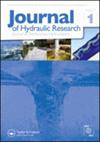Air entrainment and free-surface fluctuations in A-type hydraulic jumps with an abrupt drop
IF 1.7
3区 工程技术
Q3 ENGINEERING, CIVIL
引用次数: 0
Abstract
AbstractIn high dam construction projects in China, stilling basin design with an abrupt bottom drop is sometimes introduced to reduce the bottom velocity and pressure loads by generating A-type hydraulic jumps. Although the stilling basin design is not new, A-type hydraulic jumps have not been studied taking into account the air entrainment and evolution of internal air–water flow structures. This paper presents an experimental study of self-aerated A-type jumps in terms of bubble transport and free-surface fluctuations over the bottom drop. Four Froude numbers from 4.1 to 10.3 are tested for three drop heights, in addition to the flat-bottom case. Compared to the classic hydraulic jumps, A-jumps are observed with longer jump lengths and weaker free-surface fluctuations. The downward deflection of the jet-shear flow and formation of a bottom roller in the step cavity require a modification to the analytical expression of velocity and void fraction distributions. The relationship between the bubble diffusivity and jump spreading rate differs from that in classic hydraulic jumps, suggesting a faster expansion of the bubble diffusion layer than the turbulent shear flow downstream of the drop, especially for large drop heights. At large approach velocities, the reattachment of the deflected jet-shear flow to the lowered bed may cause a local rise in bubble counts downstream the bottom roller. Further increase in drop height results in a W-jump with overwhelming bottom roller over the surface roller and an arced surface jet, which is beyond the scope of this study.Keywords: A-jumpabrupt dropair entrainmentbottom rollernegative step AcknowledgementThe assistance of Rongcai Tang with the optical flow analysis is acknowledged.Disclosure statementNo potential conflict of interest was reported by the author(s).FundingThis work was supported the National Natural Science Foundation of China [grant no. 52192673, 51939007] and the Natural Science Foundation of Sichuan Province [grant no. 2022NSFSC0970].突然下降的a型水跃中空气夹带和自由面波动
摘要在中国的高坝建设工程中,有时会引入底部陡降的消力池设计,通过产生a型水跃来降低底部流速和压力荷载。虽然止水池的设计并不新颖,但考虑空气夹带和内部空气-水流动结构演变的a型水力跳跃尚未得到研究。本文从气泡输运和自由表面波动的角度对自充气a型跃变进行了实验研究。除了平底情况外,还对从4.1到10.3的四个弗劳德数进行了三种落差高度的测试。与传统的水力跃变相比,a型跃变具有更长的跃变长度和更弱的自由面波动。射流剪切流的向下偏转和阶梯腔内底辊的形成要求对速度和空隙率分布的解析表达式进行修正。气泡扩散率与跳跃扩散率的关系与经典的水力跳跃不同,表明气泡扩散层的扩张速度比水滴下游的湍流剪切流更快,特别是在大水滴高度时。在较大的接近速度下,偏转的射流剪切流重新附着到较低的床层可能导致底部滚子下游的气泡数局部上升。进一步增加落差高度会导致w型跃变,底部滚轮压倒表面滚轮,形成弧形表面射流,这超出了本研究的范围。关键词:a跃迁,突降携射,底辊,负阶跃感谢唐荣才对光流分析的帮助。披露声明作者未报告潜在的利益冲突。基金资助:国家自然科学基金资助项目[批准号:no. 811111196]。52192673, 51939007]和四川省自然科学基金资助项目[批准号:2022 nsfsc0970]。
本文章由计算机程序翻译,如有差异,请以英文原文为准。
求助全文
约1分钟内获得全文
求助全文
来源期刊

Journal of Hydraulic Research
工程技术-工程:土木
CiteScore
4.90
自引率
4.30%
发文量
55
审稿时长
6.6 months
期刊介绍:
The Journal of Hydraulic Research (JHR) is the flagship journal of the International Association for Hydro-Environment Engineering and Research (IAHR). It publishes research papers in theoretical, experimental and computational hydraulics and fluid mechanics, particularly relating to rivers, lakes, estuaries, coasts, constructed waterways, and some internal flows such as pipe flows. To reflect current tendencies in water research, outcomes of interdisciplinary hydro-environment studies with a strong fluid mechanical component are especially invited. Although the preference is given to the fundamental issues, the papers focusing on important unconventional or emerging applications of broad interest are also welcome.
 求助内容:
求助内容: 应助结果提醒方式:
应助结果提醒方式:


